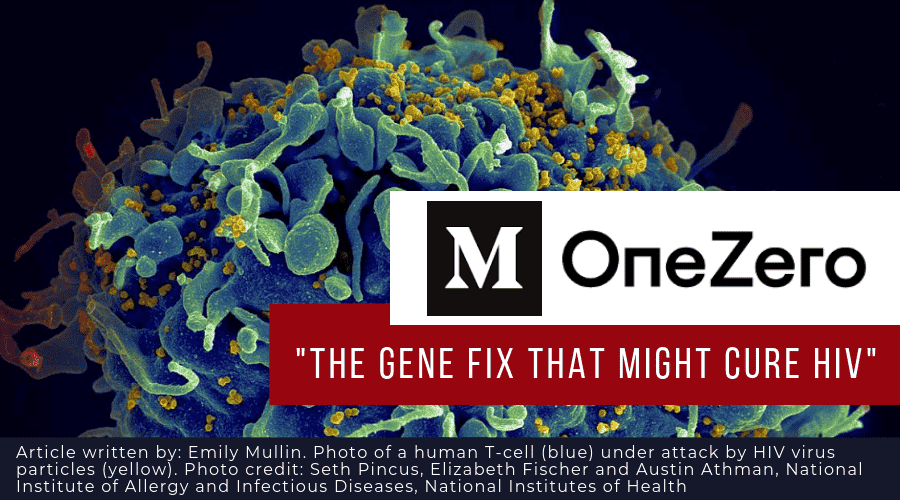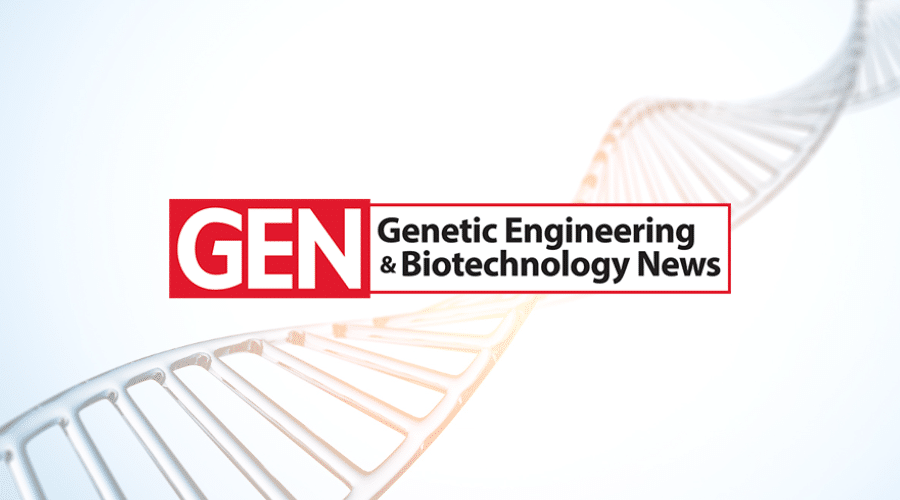One Zero: “The Gene Fix That Could Cure HIV”

Published by: One Zero Written by: Emily Mullin
Antiretroviral drugs make HIV manageable, but gene therapies could eliminate the virus altogether — provided the treatments can be made safe and economical
In the mid-1990s, scientists made a curious but remarkable discovery: A man named Stephen Crohn seemed virtually immune to HIV.
In the years before that discovery, Crohn’s boyfriend and many of his friends had died of AIDS. But despite being sexually active with men infected with HIV, Crohn himself never got sick. The reason, researchers found, was that Crohn had a mutation in a gene called CCR5, which effectively blocks the HIV virus from entering immune cells.
In the decades since, that genetic mutation — known as delta 32 — has been of particular interest to researchers studying HIV. It’s also the same mutation that the Chinese scientist He Jiankui tried to replicate when he shocked the scientific community last year by using CRISPR to edit the genes of human embryos. The twin girls who were later born were the first children whose DNA had been purposefully edited.
Now, a handful of research teams are trying to recreate the rare protective mutation in HIV patients in hopes of curing the virus. One biotech company, Maryland-based American Gene Technologies, plans to begin a clinical trial by the end of the year. Some scientists believe treatments that use genetic material — DNA or RNA — are the best hope for a one-time, long-term cure for HIV, which has killed more than 32 million people around the world. But these so-called gene therapies are not without major challenges.
So far, only two people appear to have been cured of HIV: Timothy Ray Brown, known as “the Berlin patient,” and more recently, an anonymous London patient. Both received bone marrow transplants to treat blood cancers, and in both cases, the donors harbored CCR5 mutations. In a bone marrow transplant, the recipient’s unhealthy blood stem cells are replaced with a donor’s healthy ones, which go on to make a variety of immune cells. In essence, the transplants reset the two men’s immune systems and eliminated HIV from their systems.
But it’s not practical to give all HIV patients bone marrow transplants. For one, it’s rare enough to find matching bone marrow donors, let alone those who also have CCR5 mutations. Only about 1% of people of European descent carry two copies of the mutation. A person needs to inherit two copies of the CCR5 mutation — one from mom and one from dad — to have HIV resistance. Bone marrow transplants can also be dangerous, because donor cells have the potential to attack the recipient’s cells.
“There’s an acute need to give these people something that restores their quality of life.”
Gene therapies, however, could get around some of these problems. Scientists at American Gene Technologies have engineered harmless viruses to carry a type of RNA molecule that’s designed to “silence” the CCR5 gene. The experimental therapy will involve collecting 400 milliliters of blood — about as much as in a blood donation bag — from HIV-infected patients. A machine will separate out T-cells, a type of immune cell that helps fight off infections. Scientists will use those T-cells to grow more in the lab, which will then be treated with the engineered viruses. About two weeks later, the modified cells will be infused back into the patient. The process is meant to be a one-time treatment to cure HIV.
“We think we’ll be returning the body to a normal immune system,” says Jeff Galvin, CEO of American Gene Technologies.
Scientists at the company have tested their therapy in the lab using T-cells from the blood of 13 people living with HIV. According to Galvin, the treated cells are no longer infected with HIV. The company has since formed a partnership with the National Institute of Allergy and Infectious Diseases, part of the National Institutes of Health, which is also testing the therapy in human cells.
Galvin says he hopes to begin enrolling 15 to 18 patients in the trial this fall and possibly start treating them by the end of the year. The University of Maryland, Baltimore, will be one of the study sites. To be eligible for the treatment, patients will need to have enough T-cells to make the therapy. That’s a problem, because when HIV is left untreated, a person’s T-cell levels plummet. But antiretroviral drugs, which suppress the HIV virus, partially restore these vital immune cells.
While antiretroviral therapy is very effective, it has unpleasant and often severe side effects, like appetite loss, fatigue, vomiting, and mood changes. Galvin says that’s why his company is interested in a cure. “There’s an acute need to give these people something that restores their quality of life,” he says.
Hans-Peter Kiem, director of the stem cell and gene therapy program at the Fred Hutchinson Cancer Research Center in Seattle, is one of many researchers interested in using genetic technology to cure HIV. His team has used the gene-editing tool CRISPR to introduce the CCR5 mutation in monkeys. They removed bone marrow stem cells from macaques infected with a virus similar to HIV, used CRISPR to edit the CCR5 gene, and transplanted the cells back into the animals. The edited cells multiplied and initially gave rise to healthy cells that were resistant to the virus. The procedure is similar to a bone marrow transplant, but the stem cells came from the same animal instead of a donor, reducing the risk of rejection.
Over time, though, the number of edited cells in the body declined, so the monkeys didn’t go into full remission. Kiem’s team is now working on ways to improve the technique. “We don’t know whether CCR5 editing alone will be sufficient,” Kiem says.
California-based Sangamo Therapeutics has also tried editing the CCR5 gene. The company launched a clinical trial more than a decade ago to modify T- cells taken from HIV patients with an older form of gene editing, called zinc finger nucleases. But Sangamo’s approach has had mixed results.
A 2014 study showed that in four patients, the viral load of HIV in the blood dropped. In one patient, the virus could no longer be detected at all. It turned out that patient — who has reportedly been able to go off antiretroviral therapy completely — already had one mutated copy of the CCR5 gene. However, most of the 100 patients who have received Sangamo’s treatment still need to take daily medication to suppress the virus.
Rowena Johnston, director of research at the New York–based Foundation for AIDS Research, says developing gene therapies for HIV is hard because you have to knock out both copies of CCR5 to get a protective effect. “Doing that is a lot more difficult than knocking out one copy of the gene in any individual cell,” she says.
Ironically, the sheer success of antiretroviral HIV treatment means that to get approval from the Food and Drug Administration, any genetic treatment for HIV will likely need to clear a high bar.
“People [with HIV] can be treated with one or two pills a day and essentially keep the disease in complete remission,” says Dr. Paul Sax, an infectious disease physician at Brigham and Women’s Hospital in Boston. “So any effort to improve on that has to be pretty safe.”
A recent study in Nature Medicine found that people with two copies of the CCR5 mutation might have a shorter lifespan. Researchers looked at death records from 400,000 people and found these individuals were 21% more likely to die before the age of 76 than people with only one copy of the mutation or those with two working copies of the gene.
One possible explanation for this, Sax says, is that people with these mutations are more prone to infections like the flu, which is especially deadly in the elderly. For this reason, Sax cautions that there may be unintended consequences of messing with CCR5 in HIV-positive people. “Will it have some deleterious health effect? The answer is unknown.”
Still, even if a genetic treatment succeeds at curing HIV and eventually wins FDA approval, Johnston worries that it could be too expensive for the nearly 37 million people around the world living with HIV, about 1.1 million of whom are in the United States. For comparison, other gene therapies have debuted at eye-popping prices, ranging from $373,000 to $2.1 million. Johnston says an initial cure is likely to have a similar price tag.
For all its challenges, Johnston and others think gene therapy may be the best bet at a long-term cure for HIV. “Gene therapy is probably the most promising way forward,” she says.
View The Original Article
This page is a replication of the original content. To respect the original publisher, this page is not indexed by search engines. The original article can be viewed by clicking the button below.





